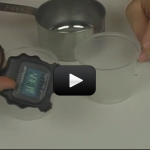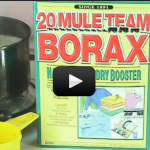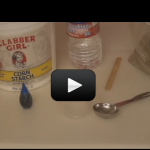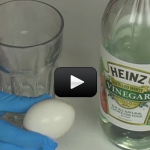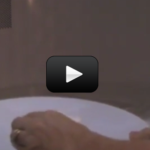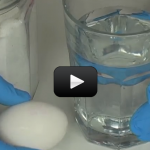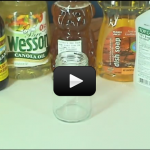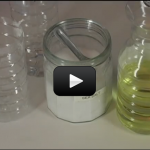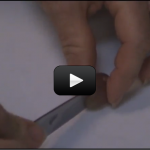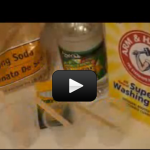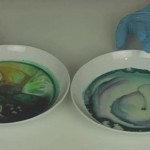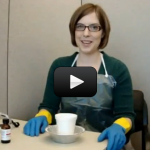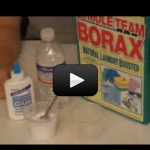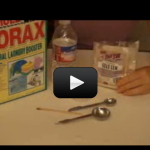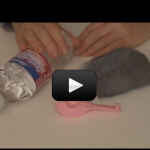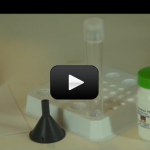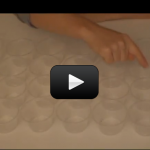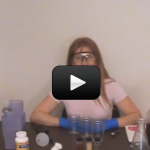How Can Water Be Used to Store Heat Energy?
Temperature is a measure of the average hotness of an object. The hotter an object, the higher its temperature. As the temperature is raised, the atoms and molecules in an object move faster. The molecules in hot water move faster than the molecules in cold water. Remember that the heat energy stored in an object … Continue reading "How Can Water Be Used to Store Heat Energy?" |
Special Science Teleclass: Chemistry
This is a recording of a recent live teleclass I did with thousands of kids from all over the world. I’ve included it here so you can participate and learn, too! (Click here if you’re looking for the more recent version that also includes Chemical Engineering.) When you think of slime, do you imagine slugs, … Continue reading "Special Science Teleclass: Chemistry" |
Laundry Soap Crystals
Can we really make crystals out of soap? You bet! These crystals grow really fast, provided your solution is properly saturated. In only 12 hours, you should have sizable crystals sprouting up. You can do this experiment with either skewers, string, or pipe cleaners. The advantage of using pipe cleaners is that you can twist … Continue reading "Laundry Soap Crystals" |
Moon Sand
A non-Newtonian fluid is a substance that changes viscosity, such as ketchup. Ever notice how ketchup sticks to the bottom of the bottle one minute and comes sliding out the next? Think of viscosity as the resistance stuff has to being smeared around. Water is “thin” (low viscosity); honey is “thick” (high viscosity). You are … Continue reading "Moon Sand" |
Rubber Eggs
If you soak chicken bones in acetic acid (distilled vinegar), you’ll get rubbery bones that are soft and pliable as the vinegar reacts with the calcium in the bones. This happens with older folks when they lose more calcium than they can replace in their bones, and the bones become brittle and easier to break. … Continue reading "Rubber Eggs" |
Microwaving Soap
When you warm up leftovers, have you ever wondered why the microwave heats the food and not the plate? (Well, some plates, anyway.) It has to do with the way microwaves work. Microwaves generate high energy electromagnetic waves that when aimed at water molecules, makes these molecules get super-excited and start bouncing around a lot. … Continue reading "Microwaving Soap" |
Salty Eggs
Did you know that most people can’t crack an egg with only one hand without whacking it on something? The shell of an egg is quite strong! Try this over a sink and see if you can figure out the secret to cracking an egg in the palm of your hand…(Hint: the answer is below … Continue reading "Salty Eggs" |
Quick & Easy Density
Density is basically how tightly packed atoms are. (Mathematically, density is mass divided by volume.) For example, take a golf ball and a ping pong ball. Both are about the same size or, in other words, take up the same volume. However, one is much heavier, has more mass, than the other. The golf ball … Continue reading "Quick & Easy Density" |
Lava Lamp
We're going to watch how density works by making a simple lava lamp that doesn't need electricity! If you like to watch blob-type shapes shift and ooze around, then this is something you're going to want to experiment with. but don't feel that you have to use the materials mentioned below - feel free to … Continue reading "Lava Lamp" |
Plasma Grape
CAUTION!! Be careful with this!! This experiment uses a knife AND a microwave, so you’re playing with things that slice and gets things hot. If you’re not careful you could cut yourself or burn yourself. Please use care! We’re going to create the fourth state of matter in your microwave using food. Note – this … Continue reading "Plasma Grape" |
Hidden Carbon Dioxide
If you’ve ever burped, you know that it’s a lot easier to do after chugging an entire soda. Now why is that? Soda is loaded with gas bubbles — carbon dioxide (CO2), to be specific. And at standard temperature (68oF) and pressure (14.7 psi), carbon dioxide is a gas. However, if you burped in Antarctica … Continue reading "Hidden Carbon Dioxide" |
Cool Milk Trick
Have you ever tried washing dishes without soap? It doesn’t work well, especially if there’s a lot of grease, fat, or oil on the dish! The oils and fats are slippery and repel water, which makes them a great choice for lubration of bearing and wheels, but lousy for cleaning up after dinner. So what’s … Continue reading "Cool Milk Trick" |
Disappearing Foam Cup
This is looks like a chemical reaction but it’s not – it’s really just a physical change. It’s a really neat trick you can do for your friends or in a magic show. Here’s how it works: |
Bouncy Putty Slime
The glue is a polymer, which is a long chain of molecules all hooked together like tangled noodles. When you mix the two solutions together, the water molecules start linking up the noodles together all along the length of each noodle to get more like a fishnet. Scientists call this a polymetric compound of sodium … Continue reading "Bouncy Putty Slime" |
Sewer Slime
Guar gum comes from the guar plant (also called the guaran plan), and people have found a lot of different and interesting uses for it. It's one of the primary substitutes for fat in low-fat and fat-free foods. Cooks like to use guar gum in foods as it has 8 times the thickening power of … Continue reading "Sewer Slime" |
Rusty Balloon
Mars is coated with iron oxide, which not only covers the surface but is also present in the rocks made by the volcanoes on Mars. Today you get to perform a chemistry experiment that investigates the different kinds of rust and shows that given the right conditions, anything containing iron will eventually break down and … Continue reading "Rusty Balloon" |
Cobalt Colors
Cobalt chloride (CoCl2) has a dramatic color change when combined with water, making it a great water indicator. A concentrated solution of cobalt chloride is red at room temperature, blue when heated, and pale-to-clear when frozen. The cobalt chloride we’re using is actually cobalt chloride hexahydrate, which means that each CoCl2 molecule also has six … Continue reading "Cobalt Colors" |
Chemical Matrix of Acids & Bases
If you love the idea of mixing up chemicals and dream of having your own mad science lab one day, this one is for you. You are going to mix up each solid with each liquid in a chemical matrix. In a university class, one of the first things you learn in chemistry is the … Continue reading "Chemical Matrix of Acids & Bases" |
Water Purification
Ever wonder how the water draining down your sink gets clean again? Think about it: The water you use to clean your dishes is the same water that runs through the toilet. There is only one water pipe to the house, and that source provides water for the dishwasher, tub, sink, washing machine, toilet, fish … Continue reading "Water Purification" |

